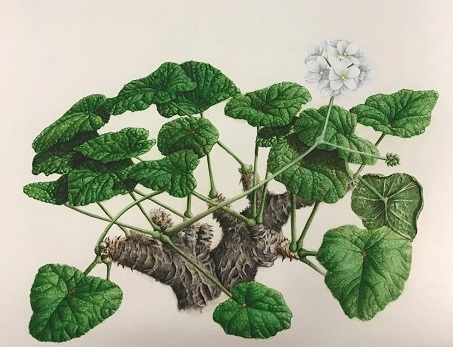In January 2020 Manshu Xu, an MSc student at Edinburgh College of Art began a work placement in the RBGE Library that involved creating an initial finding list of the collection of illustrations in the Archive Cabinets. Unfortunately, the placement had to be brought to an early end as a result of the coronavirus outbreak, but in the following blog post Manshu outlines some of her discoveries:
Working through the collection boxes of drawings inside the RBGE Archive, many mysteries unfolded. This short piece can only unveil some of them in brief.
Barbara Watts was a member of RBGE staff around the first half of the twentieth century, and the collection of her drawings is concentrated around the period from 1935 to 1940. Much of the collection consists series of delicate pencil drawings of different species within one family of plant, including details of each part of the flowers. So far, I have discovered three different series of her works, one of which contains 118 pieces; some of the works are enhanced with watercolour. They do not include geographical or publication information, which indicates they are not draw at the location where the plant was found. If one piece of work is assumed to take approximately three hours to complete, then the collection represents months of work unrecognized by the world.
One collection of Campanula drawings by Watts, all dated 1937, was accompanied by a box of related plant descriptions. Some details of this story – the detailed descriptions and the indication that they were not drawn on location – lead to speculation that the drawings and the box of descriptions are related. This all suggests that the drawings were intended for a publication that does not appear to have come about, possibly due to the difficult and unstable time before World War II. We can see that the RBGE institution probably was affected greatly during that time. There are many characteristics of the drawings that are not often seen today. One example is that today, an illustrative drawing will be done on a complete piece of white cardboard, but many drawings in this series are on scrap paper or on the corner of a piece of white cardboard. Touching the paper and looking at the cuts takes one back in time to this difficult period. Fine lines forming extreme details show her dedication and humility.
After the war, from 1948 to 1954, according to information in the RBGE archives, Norman Edward Garry Cruttwell was send to Papua as a canon. I did not find out much information about his missionary work there, but here in the RBGE archives and in the archives in Kew, he left many drawings and papers related to discovering, documenting and preserving the highland plants of Papua. At that time lowland species in Papua were more recognized than the highland species. At the end of my work, I found seven fully rendered artworks of highland Dendrobium and Rhododendron by Cruttwell in the RBGE collection. He documented each work with full colours and scientific and geographical information, and all were signed and mounted. It is easy to feel his passion for these plants from the artworks.
The collection also includes a breathtakingly beautiful artwork of Pelargonium cotyledonis, possibly by Lesley Ninnes as part of her work for the book The endemic flora of St Helena by Quentin C. B. Cronk. For some reason, it was not selected for the book. This work has been lying in the archives until the day that I rediscovered and recognized it.

Inside the RBGE Library and Archive collections there are numerous stories like the ones above, mysterious and intriguing, waiting to be rediscovered one day.
Thanks to Debi Vaile, George Sherriffs, Graham Hardy, Leonie Paterson, Lorna Mitchell.

penelope browning
Beautifully delicate art work. Lovely to see .